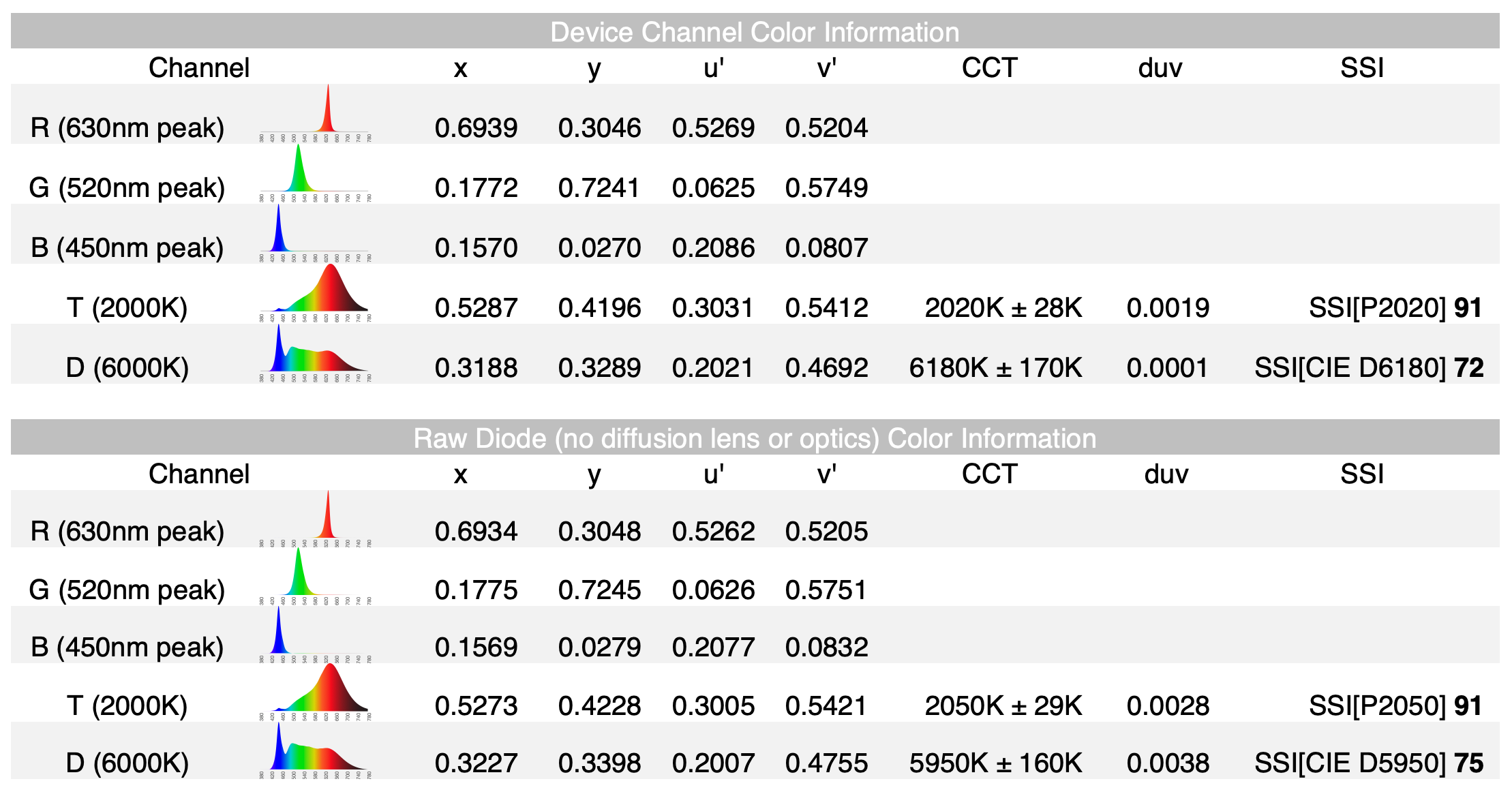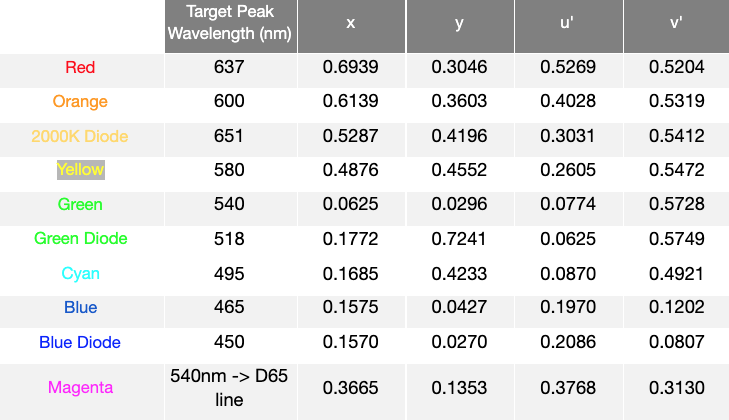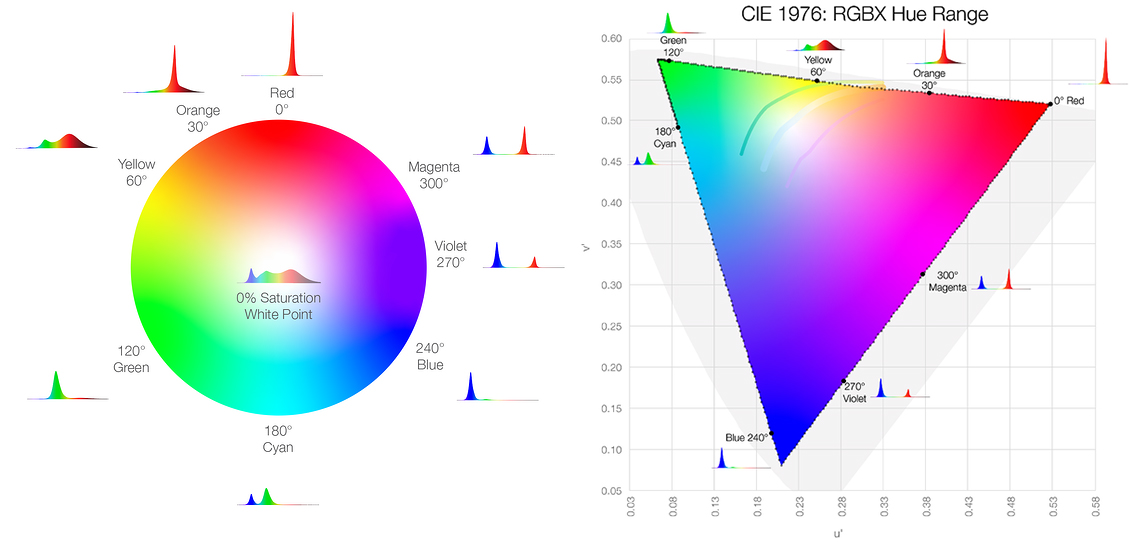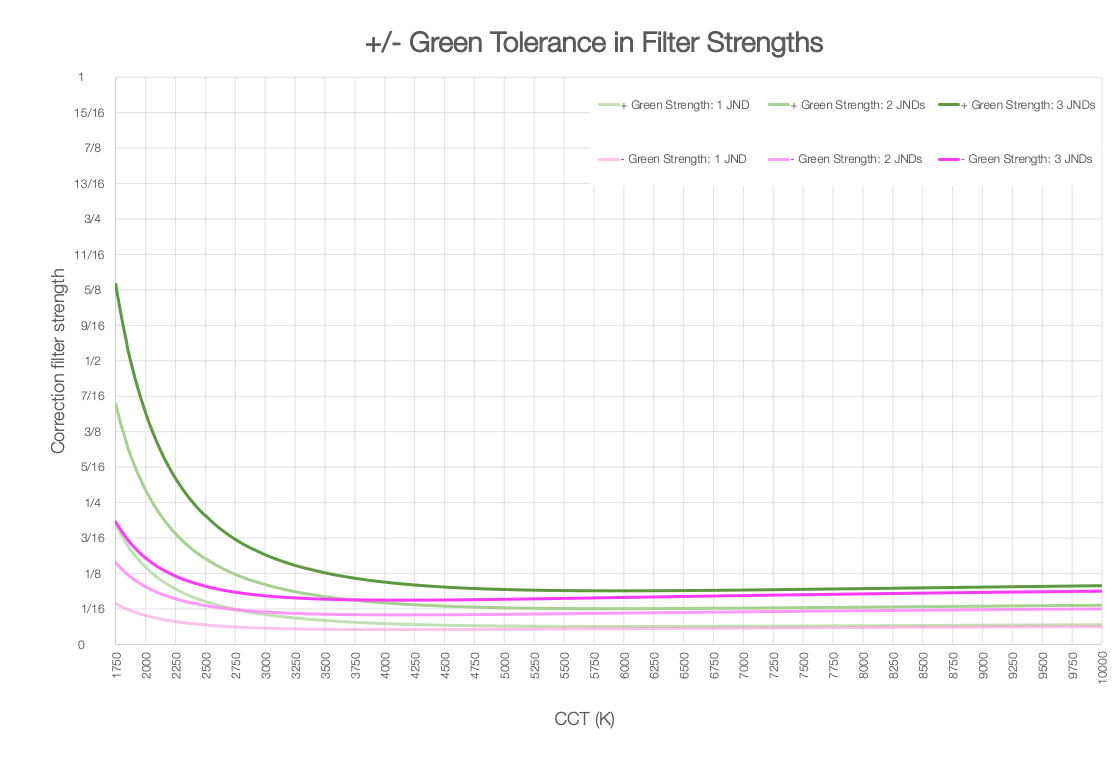Device Color Calibration & Accuracy
Calibration Targets
 |
For any given input CCT, the RGBX Spectral Science White Point Engine emulates the following TM-30-18 reference illuminant specification for both spectral and chromaticity standards:
1750K to 4000K: Planckian blackbody spectral power distribution (SPD)
4000K to 5000K: TM-30-18 Reference illuminant standard—a proportionately transitioned, linear combination of SPD between pure Planckian blackbody at 4000K and pure CIE D50 daylight illuminant at 5000K. At 4500K, the SPDs mix 50% Planckian Blackbody SPD + 50% CIE D50 SPD.
5000K to 10,000K*: CIE Daylight Illuminant series
*Above 10,000K, the CIE Daylight SSI value dips below 60, so we did not include CCT above 10,000K. Only by future demand will this extended range be added.
For +/- Green adjustments, the RGBX Spectral Science White Point Engine emulates the combination of a given TM-30-18 reference illuminant + an idealized Kodak Wratten CC36G filter as its “Full Plus Green” standard, and Kodak Wratten CC30M filter as its “Full Minus Green” standard. Legacy gels from Lee, Rosco, etc used those two filters as their targets.
For any +/- Green adjustment, the RGBX Spectral Science White Point Engine maintains the CCT of the device. In this regard, R2 and RR units slightly differ from “real world” behavior of +/- Green filtration that alters the CCT in conjunction with its intended duv change.
The 100% saturated Hue targets are calibrated as close as possible to the spectral locus of different established wavelengths for respective colors:
 |
All intermediary hues are equally spaced between the above target colors within the CIE1976 u’v’ Uniform Color Space:
 |
CCT SSI Values
The RGBX Spectral Science White Point engine attempts to match TM-30-18 reference illuminants and +/- Green filtration for any white point (CCT and +/- green) value by choosing ideal RGBX diode combinations that maximize the appropriate AMPAS Spectral Similarity Index (SSI) score:
1750K SSI[P1750] 82
2000K SSI[P2000] 90
2250K SSI[P2250] 91
2500K SSI[P2500] 89
2856K SSI[CIE A] 85
3000K SSI[P3000] 84
3200K SSI[P3200] 83
3450K SSI[P3450] 81
3700K SSI[P3700] 79
4000K SSI[P4000] 77
4300K SSI[TM30 4300] 77
4500K SSI[TM30 4500] 76
4750K SSI[TM30 4750] 76
5000K SSI[CIE D50] 76
5500K SSI[CIE D55] 74
5600K SSI[CIE D5600] 74
6000K SSI[CIE D6000] 73
6500K SSI[CIE D65] 71
7500K SSI[CIE D7500] 67
10000K SSI[CIE D10000] 61
Output Color Accuracy/Tolerance
All color settings have a chromatic tolerance to deviate from its intended specification within three Just Noticeable Difference (JND) units. This amount yields a circle within the CIE 1976 u’ v’ chromaticity space with a radius of ∆u’v’ = 0.0033.
For white light, this range of tolerance translates to a ~2.5 step SDCM / MacAdams Ellipse. In CCT & duv terms this results with the following tolerances:
1750K ±27K, ± 0.0022 duv
2000K ±41K, ± 0.0022 duv
2250K ±50K, ± 0.0022 duv
2500K ±60K, ± 0.0022 duv
2856K ±75K, ± 0.0023 duv
3000K ±82K, ± 0.0023 duv
3200K ±91K, ± 0.0023 duv
3450K ±102K, ± 0.0023 duv
3700K ±114K, ± 0.0024 duv
4000K ±128K, ± 0.0024 duv
4300K ±143K, ± 0.0025 duv
4500K ±154K, ± 0.0025 duv
4750K ±167K, ± 0.0025 duv
5000K ±181K, ± 0.0026 duv
5500K ±212K, ± 0.0026 duv
5600K ±218K, ± 0.0027 duv
6000K ±245K, ± 0.0027 duv
6500K ±281K, ± 0.0028 duv
7500K ±365K, ± 0.0028 duv
10000K ±639K, ± 0.003 duv
To help decipher the duv tolerance, the following chart illustrates the 3 JND tolerance level in +/- Green filter strengths:
 |
The top, bold lines for both colors show, for any given color temperature, the current color shift tolerance as equivalent to color shift in plus or minus green correction filters. For example, a +duv shift at 3500K, equivalent to 3 JNDs, approximates adding a 1/8th Plus Green Gel.